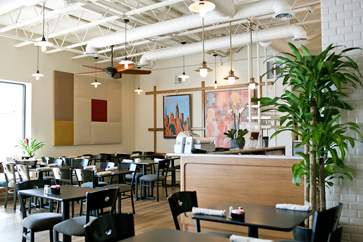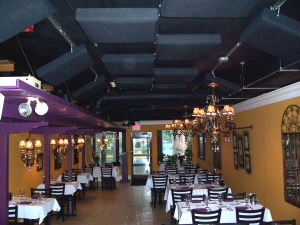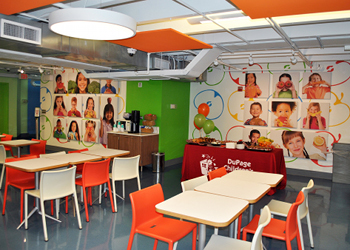Noisy restaurants are a frustrating and growing concern among many industry participants. Patrons want to converse easily without neighboring noise and echoing music. Servers need to be heard without shouting to their clients and kitchen staff. Owners strive for high reviews among a community where online reservation services now allow noise level ratings.
Simply turning the music down or accepting an energetic “hubbub” isn’t the only answer to obtaining quality acoustics in a dining or entertainment atmosphere. Adding absorptive materials, such as Acoustic Treatments, to the venue will help noise levels and conversational intelligibility.
Hard Surfaces lead to Noisy Restaurants
The days of comfortable aesthetics that favored wall-to-wall carpeting, heavy curtains, tablecloths and plush banquets are gone. As a new era of informal and fast paced dining set in, so did the push to use open kitchen plans, programmed music, exposed floors, tall ceilings, linen-free tables, and other sound-reflecting materials in restaurant designs. Though this look is sleek and easy to maintain, without the absorbing capabilities of carpet, curtains and fabric-covered seating, many restaurants are left with a reverberating, noisy chamber that affects not only a patron’s dining enjoyment, but their hearing as well.

Multi-colored Acoustic Panels form a unique design at the Sweet Basil Cafe.
Noise and the Human Ear
As sound bounces off hard surfaces, only 5% of the waves are absorbed. This leaves a whopping 95% of the sound waves free to ricochet around the room, creating an echo that can carry for up to 10 seconds. Echoes longer than 2 seconds will sound like noise because human ears only tolerate 2 or less seconds of vibration. All this excess noise is not only annoying, it can be dangerous too.
The National Institute of Health claims that prolonged exposure of 85 decibels or more can cause “gradual hearing loss” and “regular exposure of more than one minute” to 100 decibels can lead to “risks of permanent hearing loss” (Hearing Protection, NIH). According to restaurantnoise.com, the typical restaurant operates at an 80 decibel level with some reaching to as much as 110 decibels. This is as loud as a power mower! To put this in perspective, the volume needed for comfortable conversation is around 60 decibels (National Restaurant Association).
Treatments for Restaurant Acoustics
Treating a restaurant or other entertainment venue can be easy and affordable. A common aim is to create a sound level that allows patrons to hear one another, but doesn’t make it so quiet that parties at other tables can overhear the conversation.
There are many options for Acoustic Treatments that are available to restaurants, bars, clubs, wineries and cafe owners. A good way to start absorbing reverberant noise is to cover two perpendicular surfaces with sound-absorbing material. For example, by treating the ceiling with Acoustic Baffles and at least one wall with Acoustic Panels, sound waves cannot bounce back and forth both horizontally and vertically.
Another common way to treat restaurants is to place Acoustic Panels directly on the ceiling. Ted’s on Main placed these 4″ thick Acoustic Panels on the ceiling, as shown below.

Acoustic Panels mounted on the restaurant ceiling
Other creative Acoustical Treatments include using Acoustic Art Panels in place of art images throughout the restaurant. The DuPage Children’s Museum recently opened a new cafe, complete with a mural of child-friendly Acoustic Art Panels.

Acoustic Art Panels with any Image, Photo or Design
Creating a collage or design with various colors of Acoustic Panels in original or microsuede fabric can be eye-catching and blend in with the restaurant’s current color scheme. The Sweet Basil Cafe (picture located above) installed a multi-color display to effectively absorb echo in their small cafe.
Any type of Acoustical Treatment incorporated into the restaurant design will be helpful in improving both the sound quality and the quality of a patron’s dining experience. Contacting our ATS Customer Service Representatives is a great place to start asking questions about appropriate applications.
